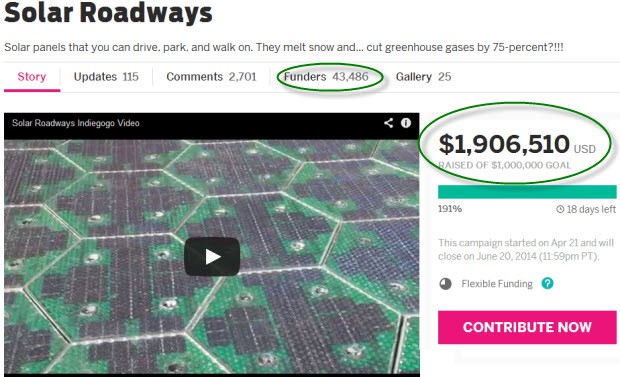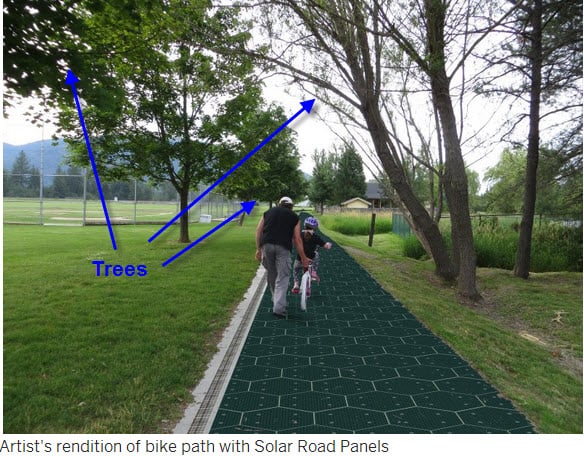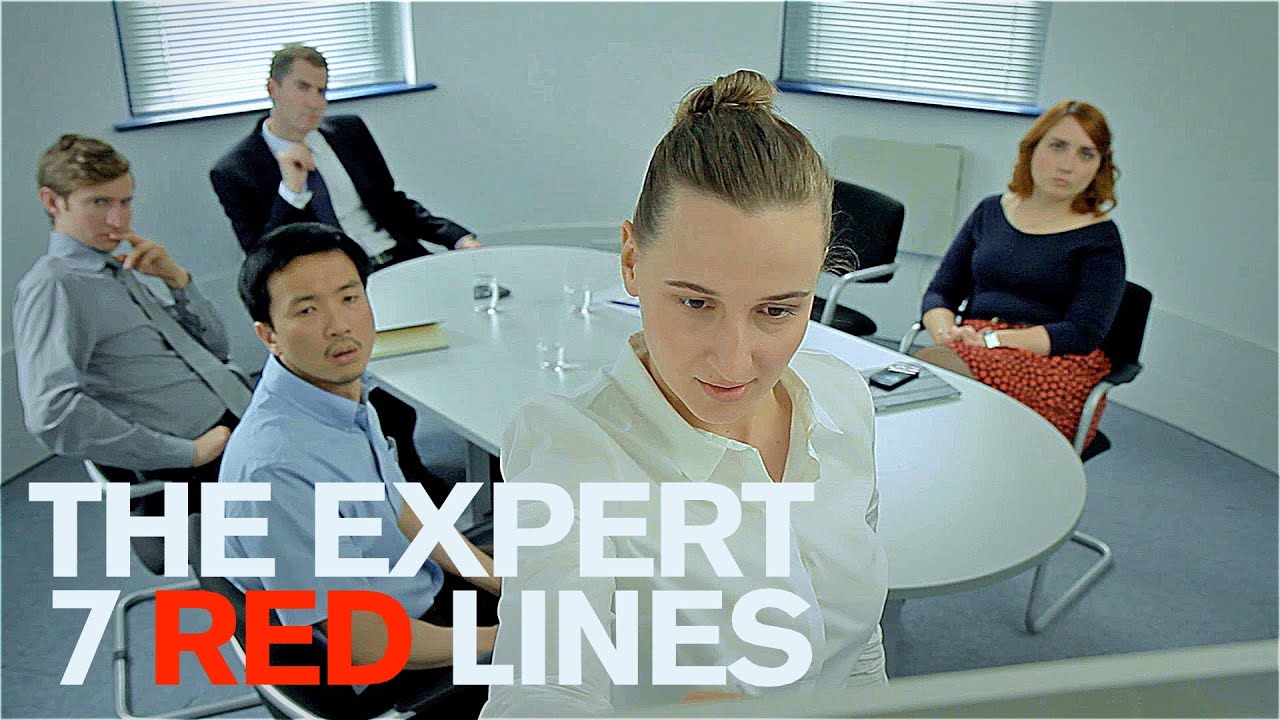A couple of the things I'm most allergic to are bad science and its partner in crime, a lack of common sense. The predicaments we face are factual and plain to see, and yet human beliefs and (in many cases) ignorance often sabotage making progress towards remedying those issues.
Recently, the idea of creating 'solar roadways' swept across the social media universe:
//www.youtube.com/embed/qlTA3rnpgzU
A lot of emails are hitting my inbox as people want to know what I think of this marvelous idea.
First, I'm quite sympathetic to the desire to find ways to turn our many liabilities into some sort of good. At first blush, the idea of tearing up our roads and covering them with durable solar panels sounds really attractive.
Understandably, a lot of people have been captivated by a slick promo video that went out across the Internet. Funds well in excess of the $1,000,000 goal have been rapidly raised from over 43,000 individuals in support:
Many 'news' sites leaped at this remarkably promising story, with EliteDaily saying, " All [the inventors] need is a little cash and we can kiss economic woes, pollution and a whole lot of car accidents goodbye forever."
Sounds great, right? A little cash and we can kiss our economic woes, pollution and most car accidents goodbye!
But, sadly, the concept as pitched is simply awful. Why?
Let me count the ways.
To begin, solar panels are barely economic when set up perfectly. That involves orienting them properly to the south (for maximum sun exposure) and tilting them just so.
Lying flat on the ground, as they would in a roadway, will be much less efficient. So, strike one.
Next, solar panels perform exceptionally poorly when they're blocked in any way (by leaves, shadows, etc) and their performance degrades when covered with dirt, grime, or snow.
If you've ever driven on a road, you know that all sorts of occlusions -- dirt, salt, grime, old mattresses lost from the roofs of inept self-movers -- are all part of the game. So if we did happen to install a solar roadway. we'd also be signing up for an extensive and permanent program of cleaning the roads, which is not a cost we currently bear. So, strike two.
Quite humorously, at the indigogo site where the hopeful inventors have taken the time to Photoshop their proposed product into a parade of exciting use cases, one of their 'visions' includes an installation at perhaps the crummiest of solar sites they could pick, seeing as how it's in the woods and all:
Still, I give this Photoshop high marks for marketing appeal, because the idea of teaching your kid to ride their bike on a solar bike path is pretty catchy.
But on the flipside, we have to wonder about the technical chops of the people involved who thought this was a reasonable way to demonstrate how their proposed product should be installed. Suffice it to say that if a solar company showed up at my house with this as an example of their work, I wouldn't hire them. More likely, I'd immediately check to see if their stock was publicly traded and short it if it was.
Next, their proposed product offering is a modular design, meaning the 'panels' come in little hexagon shapes which, in turn, means each of the panels is separate from those adjoining it. Water will get down between the border cracks, creating all sorts of roadbed erosion and ice-sponsored mischief, and that's just a recipe for disaster in most temperate climates where water falls regularly from the sky. For example, roadways here in New England where I live are constantly having to be patched and repaired due to water/ice dynamics, and that's a "seamless" surface compared to these panels.
Furthermore, such a modular design is flawed is because of poor load distribution.
What I mean by that is: imagine a very heavy truck tire contacting the front of one of these hexagons, then the middle, then the far side. As it does so, it will press down the front of the hexagon and then the back. If there's even the slightest up and down motion to this process, over time a set of compaction grooves will set up and these panels will rattle about in their little convex placements. This will create a rough ride, and eventually end up tearing apart whatever electrical connections link them together.
So, for the failure to understand roadway design basics: Strike three.
One final reservation (out of many that remain) is that of cost. Thick tempered glass is not cheap to produce, but asphalt is. I don't know what these little hexagons will cost, but I am certain that on a per watt basis they will cost more than ordinary solar panels because of the additional design features required for them to support massive loads.
I also know that very thick glass is not as good as thinner glass for solar transmission, so the panels will generate less power per unit of area. Here we simply will note that whatever electricity is generated by a solar roadway will be less than a traditional solar panel installation.
Which simply means the cost per generated watt will be higher. My guess is a lot higher, possibly an order of magnitude.
Compared to asphalt, which is very cheap to produce and is the most intensively-recycled material on the planet (with a 99% recycle rate as old roadbeds are torn up, re-melted and reapplied), I can only imagine that these solar roadway panels will be vastly more expensive than asphalt.
And while that alone isn't a good reason to spike the project, given all the other problems noted above, it certainly doesn't help.
Conclusion
I think the vigor and intensity with which people donated to this project speaks mainly to the desire to find a quick fix to our self-destructive ways. Turning our roadways into a magical paths that will end our economic woes, eliminate pollution, and reduce accidents touches right down upon that particular nerve.
But the idea simply does not pass the common sense test.
Why would we spend more on a per watt basis to get less out of a roadway when we could simply put known and proven technology up on all the vacant rooftops?
If people aren't inspired by the current returns of solar on rooftops or in open fields, they are going to positively hate the returns from the solar roadways idea. Poor orientation, shading, dirt, water and ice, wear and tear, and design considerations being driven by vehicle weight vs. maximizing solar gain are all going to erode this idea's final delivery compared to a traditional dedicated installation.
Instead of getting excited about a solar roadway, it's time to get serious about reducing our use of energy and putting what funds we have at our disposal into the myriad proven technologies that already exist and which can be implemented in known ways with calculable benefits.
Nowhere in this pitch for solar roadways that so many people have responded to is any science, economics or engineering for the viewer evaluate. There is no guesstimate of cost, no evaluation of output per unit of area, no comparison to existing solar substitutes, and no tests of dirt/grime or other occlusions showing the effect on output.
In other words, nothing that any reasonable person might use to assess whether this is a worthwhile idea or not.
From a marketing standpoint, though, I think they did fantastically. Solar FREAKIN' Roadways!!!
~ Chris Martenson
This is a companion discussion topic for the original entry at https://peakprosperity.com/no-solar-roadways-anytime-soon/


